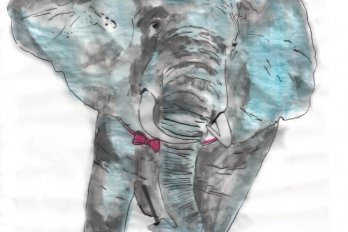burnaby — Maurice Doyle sips tea at Starbucks, waiting for his trap to fill. “Pigeon catching came just at the right time,” he muses. “Just as I was beginning to feel like my days with horses were coming to an end.” Life indeed appears seamless for the middle-aged pigeon fancier. He claims never to worry, never to plan too far ahead. “Luck” and “freedom” are often on his tongue, and rightly so. Whenever I see the Birdman, he’s in great health, especially considering the thousands of hours he’s spent atop racehorses. His stride is brisk and his handshake firm. He suggests, in his Irish accent, that I finish my tea. He’s espied some birds flying our way.
When Moe drives around the Lower Mainland, he habitually scans the rooftops. That’s how he came across this particular infestation, in a strip mall on East Hastings in Burnaby. He doesn’t need to advertise his services, since the city’s burgeoning pigeon population keeps him busy enough. When he made the mall’s management an offer to clear out the birds, “they jumped on it,” he explains. “They’d tried everything — spikes on the beams, expensive mesh to keep them out of the eaves. Nothing worked. The birds adapted, even made nests in the mesh, and continued to spatter the sidewalks in shit. Inches of it!”
Until the Birdman arrived one morning with his tools: a stepladder, a bucket of feed, and binoculars. He scattered breakfast across the tarred roof, and whirr! The birds scattered upward, into the trees. In the evening, he returned to feed them dinner. Once again, they took flight.
Two weeks later, they pecked at the seeds while Moe laid two-by-fours on the ground around them. He would eventually fasten a net to form a roof over this rectangular frame, once the birds trusted him completely. While he won them over, he made observations regarding numbers, gender, and hierarchies — information that would be useful later, in the “psychological” phase of his peculiar brand of pigeon catching. The Birdman isn’t keen on divulging trade secrets. Suffice it to say that this stage involves instilling a flight reflex in his quarry using a flashlight and an audio recording of an eagle attack.
The net ceiling went onto the frame a month into the process. One end was propped up off the tarpaper with a pole — a classic cartoon-style trap. Any hungry pigeons feasting beneath the net would be caught as soon as the rope was tugged and the pole gave way. Over the course of a few days, Moe bagged more than 150 birds, loaded them into his Infiniti, and drove them into the wilds, well past Whistler. (Their homing instinct, unless honed, won’t lead them back over the mountains.)
The pigeon wasn’t always considered a pest — a “flying rat” to be expelled, or worse. Biologically speaking, pigeons are interchangeable with doves. Both are descendants of the rock dove, differentiated only by a slight variation in size. The dove, however, received the better reputation, appearing in Greek mythology as a scout for Jason and the Argonauts through the Clashing Islands. It showed up again in the Old Testament, alerting Noah to the Flood’s end, then became emblematic of the Holy Spirit in Christian belief.
The pigeon, for its part, was a battlefield bird, its homing abilities harnessed by the likes of Caesar and William of Orange to carry orders to the front. But its utility was not limited to war. In 1150, for example, the Sultan of Baghdad created an entire postal service around the pigeon; similar ones have existed in such places as Paris and New Zealand. Slowly, though, as their numbers in urban centres grew and technology rendered their skills useless, the birds fell out of favour. Writing to the poet Milton, a friend expressed this change of attitude: “Pigeons are now a hurtful fowle by reason of their multitude and the number of houses erected daille for their increase.”
It was in sport that the pigeon found refuge, and through sport that a young Moe became familiar with the bird. His father raced pigeons in Ireland, where they were affably nicknamed the “poor man’s racehorse.” From him, the Birdman inherited the fancy.
At the same time as he was learning to handle pigeons, some local Travellers taught him how to ride horses. School gave way to jockey ambitions, but he outgrew those — quite literally, he says, thanks to a penchant for Guinness. A trip to Canada, taken on a whim, landed him a job at Hastings Racecourse in Vancouver, galloping thoroughbreds. For over two decades, he ran dozens a day. Now he pops by the track at his leisure, mainly to gallop Canada’s Sovereign Award winner, True Metropolitan, and to poke around the backstretch after invading pigeons. Once, he had to clear more than 2,500 from the barn rafters, 500 of which were crammed into his tack room.
“Sometimes I spend hours just watching the birds,” Moe tells me as we duck behind the mall. At the base of the ladder, he puts a finger to his lips. We climb. When he reaches the top, he gives the rope a tug, and the trap falls. Two pigeons thrash about beneath the netting. Gingerly, the Birdman plucks them out of the trap and puts them in his coat pockets. “Now, let’s go find a nice place to set the girls free,” he says.





